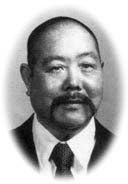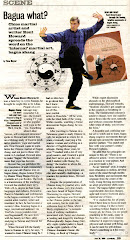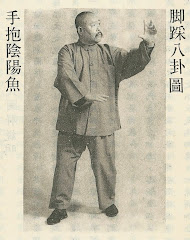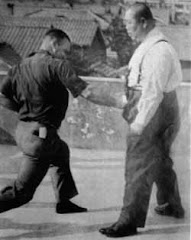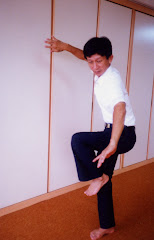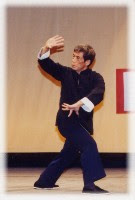
(from Wang Shujin's, Bagua Zhang Connected Palms, translated by Kent Howard)
It is said that Master Dong was a born in Wen An County in present day Hebei Province. As a young man, he loved to gamble and often got himself into trouble. Finally he had to flee his home to live in the capitol, Beijing. But being very poor, and having no one to turn to, he soon decided to travel to the south and hide in the mountains. After a journey long and fraught with difficulties, he finally reached Mount Ermei in Szechuan Province. There he happened upon two old Daoist masters named Gu Jizi and Shang Daoyuan. They asked young Master Dong his reasons for coming to the mountains, and, liking his character and bearing, decided to accept him as a disciple and teach him martial arts and transmit the He Lo Classic (an ancient Taoist text).
The two venerable priests taught Master Dong a form of walking meditation that traversed a ba gua circle. They corrected his posture and movements and instructed him saying, "Practice this technique while circling this tree until the tree begins to pursue you, then come report to us. You can feed yourself with food from the granaries and water from the stream." Master Dong was confused by their commands but did not dare to question them. He set about practicing as he was instructed and soon fell into a routine, thus setting his mind at ease. He trained long and hard for seven years until he had worn a path three-feet deep around the tree. Then one day, while circling the tree, Master Dong suddenly observed the tree begin to tremble and lean in toward him, and he achieved sudden enlightenment. This was the fulfillment of the masters' prediction that the tree would "pursue” him.
He reported his breakthrough to his teachers who congratulated him on his progress and praised him as a worthy student. They then instructed him in a method of circling two trees by walking in a figure eight. This young Master Dong did for another two years until, as before, the trees "pursued" him. His teachers again lauded him for his steadfast progress and asked if he were homesick. Dong admitted that he was. Upon hearing this, his masters praised him for not losing his human nature. They then taught him "palm" changes and weapons forms for the next two years. After which, they pronounced his skills complete.
The two old Daoist sages then bid their student farewell and bade him to leave the mountain and return to his village. But they instructed him that, as he passed through cities and towns on his journey, he was to call on the local martial art schools and accept any challenges that came his way. Being a dutiful student, he did as he was told and competed with many boxers during his travels home and was victorious over all comers. With each successful match, the fame of his skills and technique spread throughout the martial arts world.
When Master Dong finally returned to his village, he found his ancestral home abandoned and his parents long dead. It is indeed true that, "The tree wishes to rest but the wind is unceasing; the child longs to support his parents but they are gone." He mourned his parents, paid his last respects to his ancestors, and left his home for the capitol, Beijing, in hopes of establishing himself there.
Having no place to stay in Beijing, and very little money, Master Dong spent his days wandering about the Heaven's Bridge amusement district. In the evenings he slept in the open near Heaven's Altar, where the Emperor performed his annual rites on Lunar New Year. One day the martial arts teacher of a Manchu prince, Hou Zhenyuan, came to Heaven's Altar and happened to notice Master Dong. Despite his somewhat disheveled appearance, Hou observed the young man had a rugged countenance and flashing eyes. He could see that Dong was no ordinary person. After engaging him in conversation, and learning that he, too, was a martial artist, Hou asked him politely for a match of skills.
The two decided on using a straw mat, 6 x 8 feet in diameter, as their ring. Whoever stepped off the mat would be the loser. After Dong won three successive matches, Hou respectfully admitted defeat. But he was so impressed with Master Dong, that he subsequently found him a position as a servant in the palace, in hopes of him someday instructing the prince.
The prince had no knowledge of Master Dong's skills. In fact, the prince was quite proficient in martial arts, practicing daily with great fervor, and had a very high opinion of his own skill. One day while the prince was working out, Master Dong made a small comment about his technique. When the prince heard this, he was quite surprised and ordered Master Dong to demonstrate his own skills before the assembled court. Master Dong's performance so amazed the prince, he realized at once that he was in the company of a true master. Without hesitation, he asked Dong to take him on as a student. From that time forward, Master Dong's fame spread throughout the capitol.
Alas it is said, "A tall tree catches too much wind, and fame attracts envy." Master Dong soon became a magnet for every boxer within a thousand miles who wanted to test his skills against the prince's new teacher. But they all went away with their feathers plucked. Many of these braggadocios exited the palace with stolen treasures and antiques, leaving behind messages daring Master Dong to come and get them. Dong traveled far and wide to retrieve the items in martial contests. Still the challenges and thievery continued over the course of many years, and Master Dong found little rest. Finally, Dong himself was implicated in some sort of criminal activity, and, as punishment, was castrated. From that time forward, the other servants in the palace referred to him as "Old Eunich" instead of by his name.
As Master Dong grew older, he began to feel the art taught to him by his venerable masters should be passed on to the next generation. He became acquainted with an eyeglass seller who often came to the palace to repair spectacles. His name was Cheng Tinghua. Master Dong was so impressed by Cheng's sincerity that he allowed him to became his first pupil from outside the palace gates. As the years passed, he took on more and more students from Beijing's common society. Thus, over the years, the fame of Bagua Zhang (Eight Trigrams Style) has spread until it has come to rival that of Taiji Quan (Tai Chi) and Xingyi Quan (Form-Mind Boxing) as one of the three great schools of "Internal" martial arts.
When Master Tong passed away at age ninety, his students erected a mausoleum
in his memory outside the West Gate of the capitol. Each year succeeding generations of his students still "sweep his tomb" (perform memorial rites) in his honor. Though this grandmaster of a generation is gone, along with other great masters who followed in his footsteps, his art endures. However, the great social changes of our times have placed his great art in jeopardy of someday fading away from neglect. How sad!
It is said that Master Dong was a born in Wen An County in present day Hebei Province. As a young man, he loved to gamble and often got himself into trouble. Finally he had to flee his home to live in the capitol, Beijing. But being very poor, and having no one to turn to, he soon decided to travel to the south and hide in the mountains. After a journey long and fraught with difficulties, he finally reached Mount Ermei in Szechuan Province. There he happened upon two old Daoist masters named Gu Jizi and Shang Daoyuan. They asked young Master Dong his reasons for coming to the mountains, and, liking his character and bearing, decided to accept him as a disciple and teach him martial arts and transmit the He Lo Classic (an ancient Taoist text).
The two venerable priests taught Master Dong a form of walking meditation that traversed a ba gua circle. They corrected his posture and movements and instructed him saying, "Practice this technique while circling this tree until the tree begins to pursue you, then come report to us. You can feed yourself with food from the granaries and water from the stream." Master Dong was confused by their commands but did not dare to question them. He set about practicing as he was instructed and soon fell into a routine, thus setting his mind at ease. He trained long and hard for seven years until he had worn a path three-feet deep around the tree. Then one day, while circling the tree, Master Dong suddenly observed the tree begin to tremble and lean in toward him, and he achieved sudden enlightenment. This was the fulfillment of the masters' prediction that the tree would "pursue” him.
He reported his breakthrough to his teachers who congratulated him on his progress and praised him as a worthy student. They then instructed him in a method of circling two trees by walking in a figure eight. This young Master Dong did for another two years until, as before, the trees "pursued" him. His teachers again lauded him for his steadfast progress and asked if he were homesick. Dong admitted that he was. Upon hearing this, his masters praised him for not losing his human nature. They then taught him "palm" changes and weapons forms for the next two years. After which, they pronounced his skills complete.
The two old Daoist sages then bid their student farewell and bade him to leave the mountain and return to his village. But they instructed him that, as he passed through cities and towns on his journey, he was to call on the local martial art schools and accept any challenges that came his way. Being a dutiful student, he did as he was told and competed with many boxers during his travels home and was victorious over all comers. With each successful match, the fame of his skills and technique spread throughout the martial arts world.
When Master Dong finally returned to his village, he found his ancestral home abandoned and his parents long dead. It is indeed true that, "The tree wishes to rest but the wind is unceasing; the child longs to support his parents but they are gone." He mourned his parents, paid his last respects to his ancestors, and left his home for the capitol, Beijing, in hopes of establishing himself there.
Having no place to stay in Beijing, and very little money, Master Dong spent his days wandering about the Heaven's Bridge amusement district. In the evenings he slept in the open near Heaven's Altar, where the Emperor performed his annual rites on Lunar New Year. One day the martial arts teacher of a Manchu prince, Hou Zhenyuan, came to Heaven's Altar and happened to notice Master Dong. Despite his somewhat disheveled appearance, Hou observed the young man had a rugged countenance and flashing eyes. He could see that Dong was no ordinary person. After engaging him in conversation, and learning that he, too, was a martial artist, Hou asked him politely for a match of skills.
The two decided on using a straw mat, 6 x 8 feet in diameter, as their ring. Whoever stepped off the mat would be the loser. After Dong won three successive matches, Hou respectfully admitted defeat. But he was so impressed with Master Dong, that he subsequently found him a position as a servant in the palace, in hopes of him someday instructing the prince.
The prince had no knowledge of Master Dong's skills. In fact, the prince was quite proficient in martial arts, practicing daily with great fervor, and had a very high opinion of his own skill. One day while the prince was working out, Master Dong made a small comment about his technique. When the prince heard this, he was quite surprised and ordered Master Dong to demonstrate his own skills before the assembled court. Master Dong's performance so amazed the prince, he realized at once that he was in the company of a true master. Without hesitation, he asked Dong to take him on as a student. From that time forward, Master Dong's fame spread throughout the capitol.
Alas it is said, "A tall tree catches too much wind, and fame attracts envy." Master Dong soon became a magnet for every boxer within a thousand miles who wanted to test his skills against the prince's new teacher. But they all went away with their feathers plucked. Many of these braggadocios exited the palace with stolen treasures and antiques, leaving behind messages daring Master Dong to come and get them. Dong traveled far and wide to retrieve the items in martial contests. Still the challenges and thievery continued over the course of many years, and Master Dong found little rest. Finally, Dong himself was implicated in some sort of criminal activity, and, as punishment, was castrated. From that time forward, the other servants in the palace referred to him as "Old Eunich" instead of by his name.
As Master Dong grew older, he began to feel the art taught to him by his venerable masters should be passed on to the next generation. He became acquainted with an eyeglass seller who often came to the palace to repair spectacles. His name was Cheng Tinghua. Master Dong was so impressed by Cheng's sincerity that he allowed him to became his first pupil from outside the palace gates. As the years passed, he took on more and more students from Beijing's common society. Thus, over the years, the fame of Bagua Zhang (Eight Trigrams Style) has spread until it has come to rival that of Taiji Quan (Tai Chi) and Xingyi Quan (Form-Mind Boxing) as one of the three great schools of "Internal" martial arts.
When Master Tong passed away at age ninety, his students erected a mausoleum
in his memory outside the West Gate of the capitol. Each year succeeding generations of his students still "sweep his tomb" (perform memorial rites) in his honor. Though this grandmaster of a generation is gone, along with other great masters who followed in his footsteps, his art endures. However, the great social changes of our times have placed his great art in jeopardy of someday fading away from neglect. How sad!


